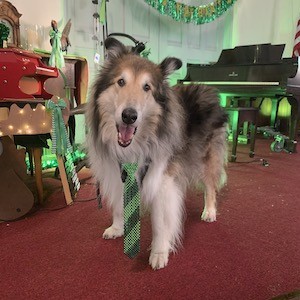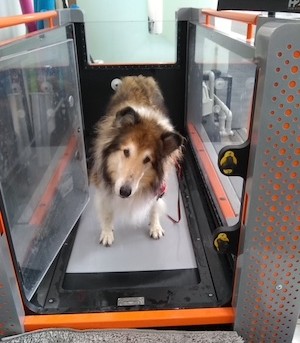Persistent rehab helps aging collie recover from dislocated hip
By Melanie Greaver Cordova
Max the rough collie is still spry at age 10 – he even co-hosts two weekly music programs on Facebook Live – but last May his exuberance led him to the emergency room at the Cornell University Hospital for Animals (CUHA).
Thanks to veterinarians at Cornell and the careful dedication of his owner, Mark Brown of Lodi, New York, Max is back online and has become an example of what rehabilitation therapy can do for an injured pet of his age.
Max’s misadventure began when he ran toward a truck while on a lead in the yard. He jumped up but misjudged the length of the lead, which pulled him down hard on his right rear leg.
“It was obvious he was hurt right away,” Brown said. “He’d never cried like that before.”
Max was rushed to CUHA, where veterinarians gave him pain medicine and diagnosed him with a traumatic hip luxation, an extreme and damaging dislocation of his hip joint. Cornell veterinarians advised a femoral head ostectomy (FHO), a surgical procedure which removes the ball of the hip bone. The leg muscles would then hold the femur in place until scar tissue formed a cushion.
Brown and Max’s primary veterinarian agreed this was the best course of action.
“It sounds kind of scary, you know, taking the ball from a dog’s leg,” Brown said, “but I talked to my vet and she agreed it was absolutely the way to help Max walk again.”
The FHO went well and Max’s care team described him as a sweet and model patient. With the immediate situation taken care of, all attention now turned to helping Max walk again.
“A few of the hallmarks following an FHO are atrophy of the muscles in the surgical limb, since the animal isn’t using it as much initially, and decreased hip extension,” said Allison Miller ’03, D.V.M. ’07, lecturer in the Section of Sports Medicine and Rehabilitation (SMR). “Rehab is aimed at strengthening the muscles that help provide stability to the pseudo hip joint, and helping to preserve and possibly improve the patient’s range of motion of the hip.”
Max entered his rehabilitation therapy with Miller and the SMR team, with goals of managing his pain, encouraging low-impact weight-bearing activity and building hind limb muscle strength – all while keeping the collie at an appropriate weight.
“We started out going twice a week in June,” said Brown. “Once I witnessed the benefits of the first round of therapy and the care and attention given to Max’s welfare, I was very eager to continue.”
As an older pet, Max had a few other underlying non-surgical conditions that the SMR team was able to target with much of the same focused rehab used to help him recover from surgery. Max responded well to his rehabilitation therapy, which consisted of in-home exercises that strengthened his hind limb muscles – especially those that support his hip – increased his endurance and improved his spatial awareness.
The SMR team combined these exercises with twice-weekly underwater treadmill therapy. “By placing the height of the water at Max’s hip level, we are able to decrease the stress on his joints,” Miller said.
The movement of the treadmill belt and the warmth of the water helps make the soft tissues more pliable during the session and helps with hip extension.
Max’s dry land exercises were also customized to help repair and challenge his muscles, and varied from lifting alternate legs to encouraging him to walk backward.
Brown continued bringing Max to Cornell for therapy throughout the winter, and also built ramps for him at home to help him get around. “What’s really great about the SMR team isn’t just their kindness and attention – they were able to lead me through exercises I could do with Max at home,” Brown said.
“We are so fortunate to work with pet owners who have this dedication,” Miller said. “From the beginning, Max’s dad always wanted to improve Max’s quality of life and functional mobility.”
Due to his injury, Max had to take a break from “Midday Music with Mark and Max,” which Brown – a musician and organist at the Hector Presbyterian Church – began doing for both their congregation and the Lodi Historical Society last spring. His audience was delighted when he returned.
“He’s made great strides throughout, but he’s particularly stronger over the last 10 weeks,” Brown said. “He’s become much stronger and increasingly more independently mobile at home. When he falters, he’s able to correct himself. That’s part of the objective, to enable him to have sufficient ambulatory ability to get around at home on his own.”
Read the full story on the College of Veterinary Medicine website.
Melanie Greaver Cordova is assistant director of communications at the College of Veterinary Medicine.
Media Contact
Get Cornell news delivered right to your inbox.
Subscribe


